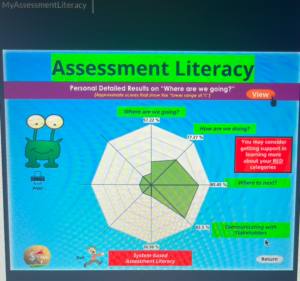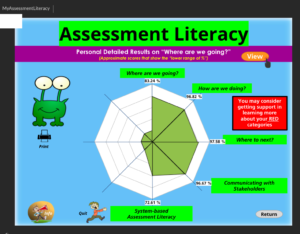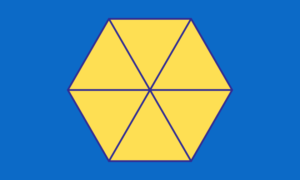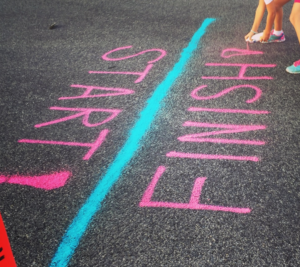Hello!
Down below is a PDF of my 5 Big Ideas from ECS 401. Enjoy!
ECS 401-Baylee Anderson’s 5 Big Ideas
Best, Baylee
Hello!
Down below is a PDF of my 5 Big Ideas from ECS 401. Enjoy!
ECS 401-Baylee Anderson’s 5 Big Ideas
Best, Baylee
Hello!
Below is a link to watch a video and view my document on my Assessment Plan Showcase for my ECS 401 class. Enjoy!
Best, Baylee
Baylee Anderson- ECS 401- Flowers/Environment Grade 3 Assessment Plan Showcase Document
Video of me giving a shorter description of my Assessment Plan Showcase
These are my Assessment Literacy quizzes from the beginning and the end of the semester in my ECS 401 course

This is from January 10th

This is from April 8th
At the beginning of the semester, I had never really thought of the specific topics brought up in the quizzes. I was not confident in being able to answer questions based around the numbers and specific statistics. My confidence and knowledge has grown on all of the topics, but mostly I now have a better base to configure my opinions around. When it comes to assessment, I feel more insightful and capable of incorporating and trying different avenues of assessment. Overall, the quizzes further proved how this class has benefitted me as a person and in my Education Career.
Best, Baylee
At the beginning of the class there was a focus conversation about Pre-Internship. I personally have not gotten to the point in my schooling journey to be in my 3 week block yet. I have been taking a full class load, while taking multiple spring classes- I wanted to take this class now (at the end of my 2 & 1⁄2 year of University) to make it easier on myself when I am in my semesters of Interning. This was nice to still be a part of in the sense I was able to get an idea of what some of my peers experienced during their time in their internship. We did a PollGuru to facilitate conversations and opinions of what was seen in everyones classrooms during their experiences. This was a beautiful way of fitting all the pieces of assessment into a whole! Which leads me to my symbol this week.
This week my symbol is the yellow Hexagon used while teaching fractions to represent a whole. The idea that this Hexagon can be separated into different fractions- all that can add up to be a whole and construct different pieces of an idea. Some pieces of assessment use COPS- as was mentioned in the class on Wednesday, “Conversation, Observations, Products” each represent ⅓ of putting together parts of assessment to make a successful whole.
We also went over the Class Community Summary Score Sheet for our Dialogue Papers. There are also three points that make up this form of assessment- There were the scores, the Range, and the Mean. This made up my Dialogue Papers fraction. I found it to be an enlightening process as well. I got a better understanding of how my peers like to assess and understand what I wrote- it meant different things to different people, which I wholeheartedly respect.
Another task we went over was the Fraction activity. In itself it represents my fraction symbol, however, this activity had multiple pieces making it a whole. I was able to complete the Fraction activity a couple of weeks ago, then myself and a peer came together to decide how we would assess those who have completed the activity (what question is worth what points and what category they land under: Intellectual, physical, or Spiritual), finally we looked at how the Fraction activity is marked and what category each question falls into. This helps to make us look at data in a thoughtful way!
Overall, this class helped to make some more pieces of the fraction for Assessing and learning easier!
Best Baylee

During this class we spent a majority of it grading our peers’ papers, and ourselves. This was a wonderful teaching experience. I only wish that we could have had more time to do more in depth marking. I have done peer assessing in other classes and I thoroughly enjoy the opportunities to practice giving additional feedback in comments. This also gave me multiple perspectives on how my peers viewed the assignment and completed it, they were all different in their own ways with all different approaches.
Therefore the symbol I want to use for this blog is a start and finish line- this supports the ideas of achievement, but there is always another step after completion or finishing a task. Life is constantly moving, we are constantly trying new things, or completing old things, etc. There is always a next, and whether it is us finishing a Paper, or us starting to mark another’s paper, we are always facing a start and finish hand and hand. To me this is also a beautiful picture that implies growth, comfortability, and stepping out of our comfort zones. All parts of education, and life.
We also completed a puzzle task about the bigger topic of Visual Learning that was taught to us during this class. This was completely new information to me- I am at another new starting line. This led us to learning about Meta Analysis, which is the study of studies, as well as about standard deviation. There is a relation to apples and oranges, with effect size and how they show this whole idea is not just about apples and oranges but about growth!
Another thing that was mentioned that I also agree with is the idea of the Key of Visible Learning- “Learning occurs best when teachers see that learning through the eyes of their students, and students see themselves as their own teachers”.
We then finished the class off with a fraction activity. It has been a long time since I have done fractions in this form. While I was answering, it was funny to me how all this information came from the back of my mind without a second thought. It was fun! I got them all right however the activity glitched and I was unable to get a screenshot of it off of my computer.
Overall, this class had many new starting lines that will grow my experience on my Education journey!
Almarode , J. (2023, June 1). The Visible Learning Research. Visible Learning. https://www.visiblelearning.com/content/visible-learning-research
Here is a Link to the Visible Learning Website

This is my Updated Professional Dialogue Paper for the ECS 401 course I am taking, click below to read!
Enjoy!
ECS 401 Professional Dialogue- Dialogue Paper
Best, Baylee
During this class we went over some heavy and controversial topics! Growing up, I was told to never talk about Sex, Religion, or Politics. When topics like these are brought up, I tend to be taken out of my comfort zone. I feel like these are conversations that we should be having. The more we talk about them, the more we will be able to address one another with respect and understanding. I love to talk about my opinions and to address my ignorance on the topics I do not know anything or very little about. Part of becoming an Educator and even looking at myself as a human being going through life, being uncomfortable and breaking down your walls is an important part of self growth. Going forward, I feel like, by taking these steps, I am doing my best to be constantly learning and being able to provide a knowledgeable, safe, and inclusive classroom. When we are uncomfortable with what we do not know or understand, how do we change that? We learn. We need to open our minds and hearts to other perspectives, other facts, and do our best to learn in an unbiased way- this way we can teach in an unbiased way. For my symbol for this blog, I have chosen an Earth surrounded by diversity: diverse knowledge, cultures, colours, understandings, and perspective. In order for us to properly feel the past class, we need to understand that we are just one person with our own thoughts, backgrounds, and education. We all make up with the planet and in order to go further, we need to come together.
We went over a What Is Culture activity in class where we had to talk about and discuss what makes up culture. There were times when the whole class was on the same page, then when we were 50/50 split. This led to very interesting conversations that we came to learn that, these conversations were had by those in the Province. It is hard to have those conversations, yet impactful- we should be encouraged to be having these conversations and learning about these very topics. * see the document below *
Going forward, we participated in a Poll Guru (which is one of my favourite activities in the class). The first Poll Guru was based on how we are doing and how we feel about our assignments with assessing. This further touches on the symbol of all of us being our own individual selves, with our own thoughts and interpretations.
We also went through the 15 Fixes. The fixes of distortion, for low quality evidence, for bad grade calculations, and to fix support learning * see document below *. These were insightful to read through and work through with my peers. We sorted the items around in the ways that we believed were the most useful to not as useful as fixes. This pushed for conversation between those in my group to discuss how we believe each fix is useful in a classroom. This again proves the importance of my symbol for this blog being about the individuality around the world.
We went over something that I had never heard of before which is the PISA- Programme for International Student Assessment and the PCAP- Pan-Canadian Assessment Program. This is based on assessing students and comparing them in the subjects of: Reading, Science, and Mathematics. This is about all of the individual learners across the Earth, who learn differently across the globe.
These are areas that we should be acknowledging and analyzing as educators who assess and teach. In order for us to take the next steps, we have to have difficult conversations and be willing to stretch and evolve our own knowledge in the process.
Thank you for Reading!
Best, Baylee

Here is the Feedback and my own Self-Assessment from my Professional Dialogue Paper!
Feedback & Self-Assessment on Dialogue Paper
During this week, I missed the physical class. However, I did not miss out on the content of the textbook and the peer feedback for my Professional Dialogue Paper! The chapters due to be read for this week were chapters 9, 10, and 11, which were the last chapters of this text book. My symbol for the content and tasks of this week is a light bulb. A light bulb turns on when given energy/power, if our brains are the light bulbs, ourselves, peers, assessments, communication all feed towards powering our personal light bulbs.
Chapter 9 is based on communication with learning, chapter 10 is on evaluating and reporting, and chapter 11 is based on learning by ourselves and with others. These three ideas are critical standing points when it comes to working together, working alone, assessing, learning, and how communication benefits these processes as a whole.
Going further, in chapter 9 “there are two parts to successful communication about learning: 1. Students collect and demonstrate their learning. 2. Audiences respond with feedback” (Davies, 2020, p. 86), with communication and assessment, this further adds to our growing light. This give and outlet to practice demonstrating what we know and doing so in a healthy way that lets us learn and apply more successfully over time. All while the student or ourselves are being the sources of our own learning and progression.
Learning to understand what we know and how to evaluate it and send it forth in a strong skill that adds onto our shining light. Triangulation is a strategy that supports the criticism process in a way that is not negative or looking down on students, others, or ourselves “Triangulation of evidence- looking at evidence from three different sources- is essential because it puts single pieces into context… the evidence students have collected, the self-assessments they have made, our observations, criteria-based assessments attached to projects or assignments, performance grids, rubric scores, and grades from projects and tests” (Davies, 2020, p. 95). This is a way of utilizing ourselves, communication, and working together to build onto what we know.
The last chapter dives into Learning Circles. Personally, I have extremely enjoyed the Learning Circles and what the process, my peers, and myself offers to the table when we all come together “Learning circles- places where people learn from each other”(Davies, 2020, p. 105). This strategy applies all that we have been learning in one strong approach- being able to learn from one another is a great skill to have and fuels our lights.
I also received and provided peer feedback on my Professional Dialogue Paper. I love any opportunity to practice my assessing and feedback before having to go into the workforce. While reading the other person’s paper, I would find myself asking myself how I would want to receive any feedback. I wrote down my notes of my raw thoughts on another paper while going through the paper. Once I finished reading with my first impression, I read the paper again. Then I went to my notes and sifted through my suggestions and thought about how I would be able to go forward if I received any of the feedback. This gave me an outlet to provide key suggestions in a positive, healthy, yet informative way, while using the sandwich technique. I still had a layout of small critiques, then I gave my full bulb of positivity and growth. Not only was I feeding to another’s light, but my own as well.
Davies, A. (2020). Making Classroom Assessment Work (4th ed.). connect2learning.

This is my Professional Dialogue Paper for the ECS 401 course I am taking, click below to read!
Enjoy!
Baylee Anderson’s Professional Dialogue Paper
Best, Baylee